The Soil Mechanics Research Group (SMRG) operates as part of CiviLab in the Department of Civil Engineering in the Faculty of Engineering, Built Environment and Information Technology.
Why does the group exist?
The SMRG was set up specifically to look into the problem of damage to light structures (particularly RDP houses) caused by founding on expansive soil. This is a very common problem in the semi-arid area of Central South Africa.
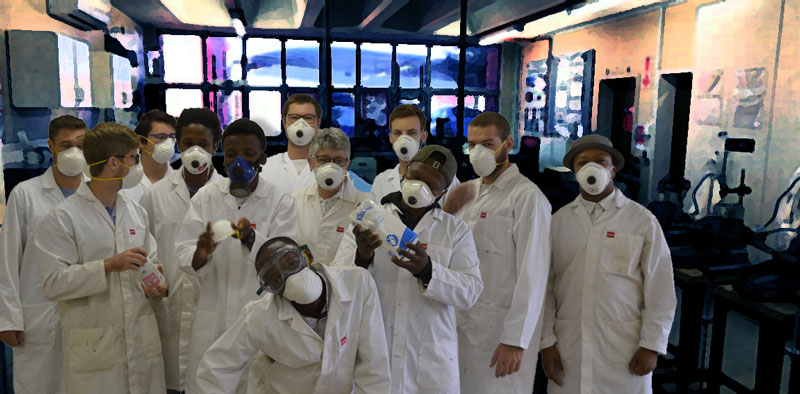
What is the SMRG research focus and the history thereof?
The first thrust of the research effort was to assess the reliability of the procedures currently used to assess heave potential. It was found that there are a number of major flaws in current assessments. By far the most commonly used method is that proposed by Van der Merwe.
It is the method which the NHBRC requires for heave classification. Van der Merwe’s method relies on laboratory testing to provide Plasticity Index (PI) and clay fraction. The SMRG very quickly came to the conclusion that there are serious weaknesses in the method itself and in the tests to establish its two essential parameters.
Van der Merwe justified his method based on the results of field tests on four houses. At one house there was excellent agreement between his predicted and observed heave. At two houses there was reasonable agreement, and at the fourth house (where heave was more severe) his method predicted only half of that which occurred. This hardly seems to be adequate grounds for the method to have become the standard which thousands of buildings depend on for satisfactory performance.
In 1963 when Van der Merwe put forward his method, the Liquid Limit (LL) used to establish the PI was determined by the three-point flow-curve method. Sample preparation involved adequate time for moisture to become evenly distributed throughout the soil (typically 24 hours). The current soils testing standard, SANS 103001, calls for a one-point procedure with a preparation time from dry powder to test completion of 10 minutes. Extensive testing at the SMRG has shown that for high plasticity clays 10 minutes is totally inadequate for absorption of water, and that PI for many high plasticity clays rises quite rapidly in the first hour after imbibing water and continues rising slowly for many hours thereafter. Also, SANS 103001 only recommends a three-point flow curve LL determination where it is expected that the PI may be greater than 20. This is practically never done.
An even more serious challenge to the usefulness of Van der Merwe’s method was discovered with the hydrometer’s value of clay fraction. In two RDP housing projects, where a very large proportion of the houses had to be demolished as unsafe within 5 years of completion, it was discovered that hydrometer analysis had drastically under-estimated the clay fraction, and therefore the heave potential. It was found that some soils do not respond to the dispersion procedure specified in SANS 103001 and their high cation exchange capacity (CEC) clay particles remain tightly bound to silt and fine sand particles despite chemical and mechanical dispersion – resulting in misleading hydrometer values.
Further tests, on a wide variety of soils, in which the sediment in the hydrometer was extracted and examined, showed that it is common for agglomerations of high CEC clay and silt to be found at any level in the sediment. Other tests observed such agglomeration taking place rapidly under the influence of highly charged clay particles within minutes of the start of the hydrometer settlement procedure. It appears that the hydrometer may be far less reliable than has long been thought.
A rapid increase in understanding of unsaturated soil mechanics in the last few decades has led to an appreciation of the importance of soil suction and its influence on many soil properties, including expansive potential. Several methods of assessing heave potential using suction values have been proposed but do not appear to have become popular, probably because of a shortage of expertise and apparatus required for suction measurement.
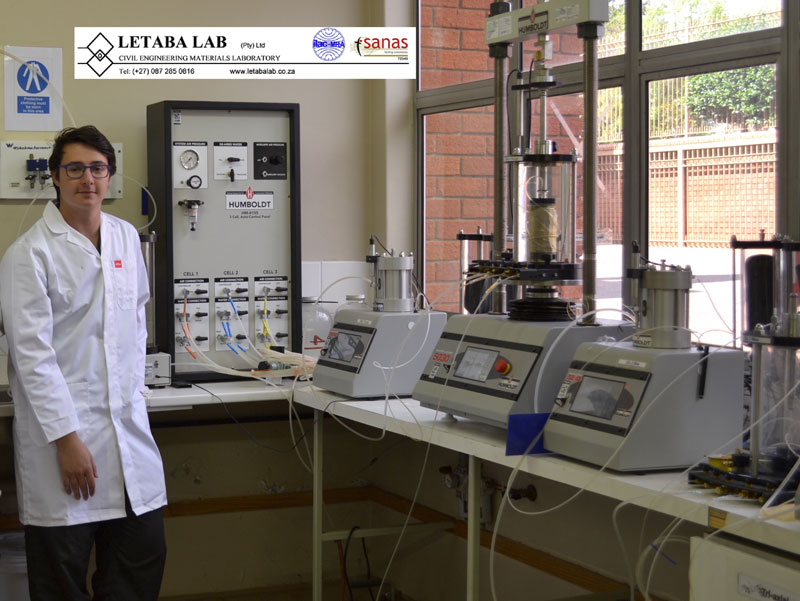
CUT WIL student, Yanis Glynos, with the state-of-the-art triaxial testing equipment sponsored by Letaba Lab.
How is the SMRG approaching suction potential?
The SMRG has been working on procedures for assessing suction potential of soils quickly, easily and economically. These procedures not only appear to give good estimates of heave potential, but also of variability. Comparisons between soils from construction projects which have failed and others which have not failed suggest that variability is a very significant contributor to failure.
The SMRG is also looking into addressing the problem of heave damage by combining structural and geotechnical design. The normal method of solving the problem of heave damage is to provide a foundation stiff enough to limit distortions imposed on the superstructure to very small values. This may require raft foundations with deep and heavily reinforced stiffening beams.
A more economical solution may be to use mortar which is flexible enough to allow significant distortion in the masonry before cracking. This flexibility needs to be combined with sufficient bonding strength to the masonry units to limit separation of bricks from mortar. Unfortunately, the quality of masonry in South Africa has reached a very low level. Over-attention to minimising cost has led to extremely poor standards of brickwork in general and mortar in particular. Tests at the SMRG have found that practically none of the sand currently used for masonry in the Free State comes close to meeting the water-demand requirements of the masonry code, and hence they cannot even produce mortar with an acceptable water-cement ratio. SMRG is working on mortar mix design which can meet the requirements of the masonry code, give good bond strength and flexibility, and which can be integrated with geotechnical design to optimise the solution to the problem of heave damage.
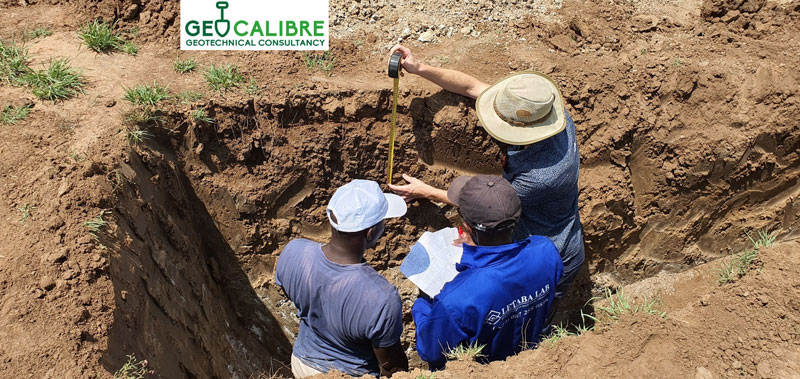
Profile logging in test pits, training by GeoCalibre.
Who is part of the SMRG?
The research group currently consists of several staff members, Work Integrated Learning (WIL) students, post graduate students and one research fellow. The group works closely with the industry to ensure that practical and relevant problems are addressed in order to enhance quality of life.
Current industry partners are GeoCalibre; Letaba Lab; Protsurv; Cem Brick and SC Consult. We are extremely grateful for the financial and human resource inputs from our industry partners. Protsurv sponsored a training workshop to Chicago, USA, which led to a follow-up workshop presented by a member of our group. Kevin Coertzen from GeoCalibre is investing a great amount of time to ensure our students are aware of the importance of geotechnical investigations. Letaba lab have sponsored all our advance geotech equipment (state of the art oedometers, shearboxes and triaxials) in order to provide an environment to test at the level required by the South African National Accreditation System (SANAS).
International collaboration includes a MoU with the University of East London (UK) and the Royal Academy of Engineering (UK). The group also collaborates with the civil and structural engineering unit at Szecheyni Istvan University in Hungary.

CUT WIL students in class at GeoCalibre for on-site investigation training.
Join us on Facebook or LinkedIn
CUT enquiries:
- WIL opportunities
- Research opportunities (M.Eng; D.Eng and Postdoc: Civil)
- Geotechnical engineering testing related to research and/or duplicate testing (industry);
- Online training/workshops;
- Industry in need of WIL students on a short term (1-3 months) basis;
Contact Prof. Lize Theron, etheron@cut.ac.za
Industry related enquiries:
- GeoCalibre (geotechnical services and site investigations): kevin@geocalibre.co.za
- Letaba Lab (Material testing): jayson@letabalab.co.za
- Protsurv (Equipment and calibration): tiaan@protsurv.co.za; dc@protsurv.co.za
Our Partners
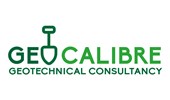
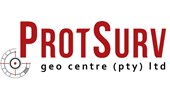


Faculty of Engineering, Built Environment and Information Technology

CUT and W&RSETA launch ‘Tshireletso Ka Thuto’ to improve food safety in the Free State
CUT News Research and InnovationProf. Ryk Lues, Chair of the CUT Research Leadership Chair, Ms. M Semenyane, participant of 'Tshireletso...

CUT Researcher Awarded Prestigious National Funding to Advance Curriculum Reform
CUT News Research and Innovation Welkom CampusDr Mantoa Contravetra Molete, Lecturer and Departmental Manager in the Department of Communication Sciences...

CUT Research Winter School inspires a new wave of scholars and supervisors
CUT News Research and Innovation Welkom Campus“The Research Winter School gave me a new dream, I want to be a research guru now,” says Ms. Mangaleni Hlatywayo,...

